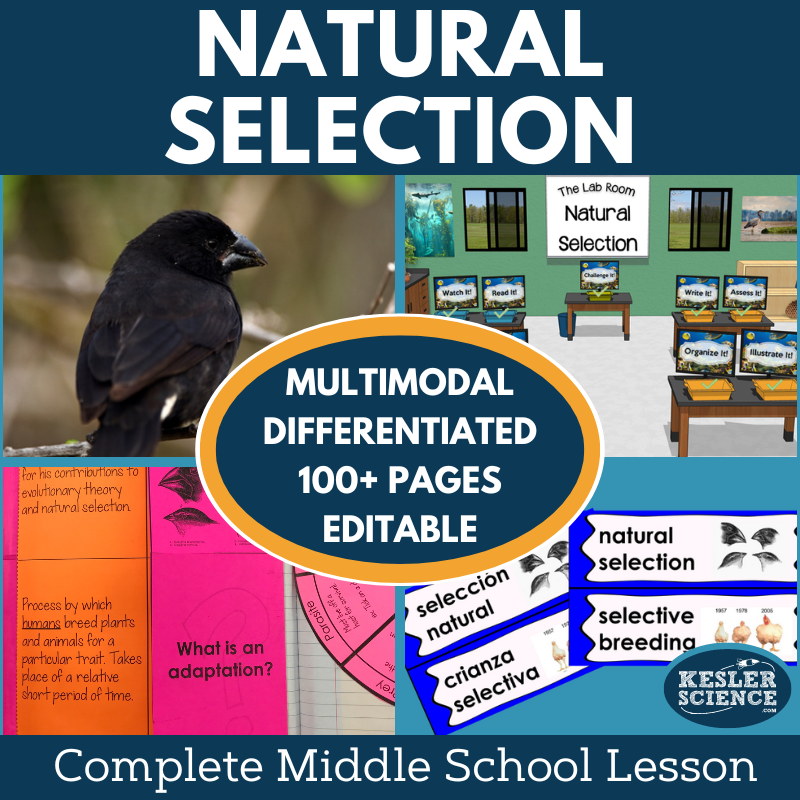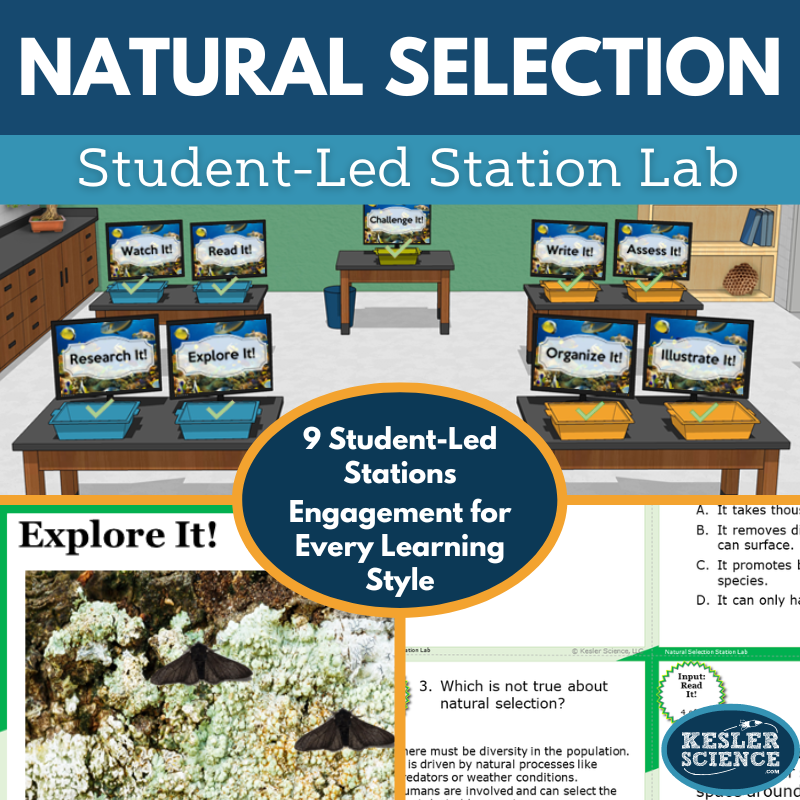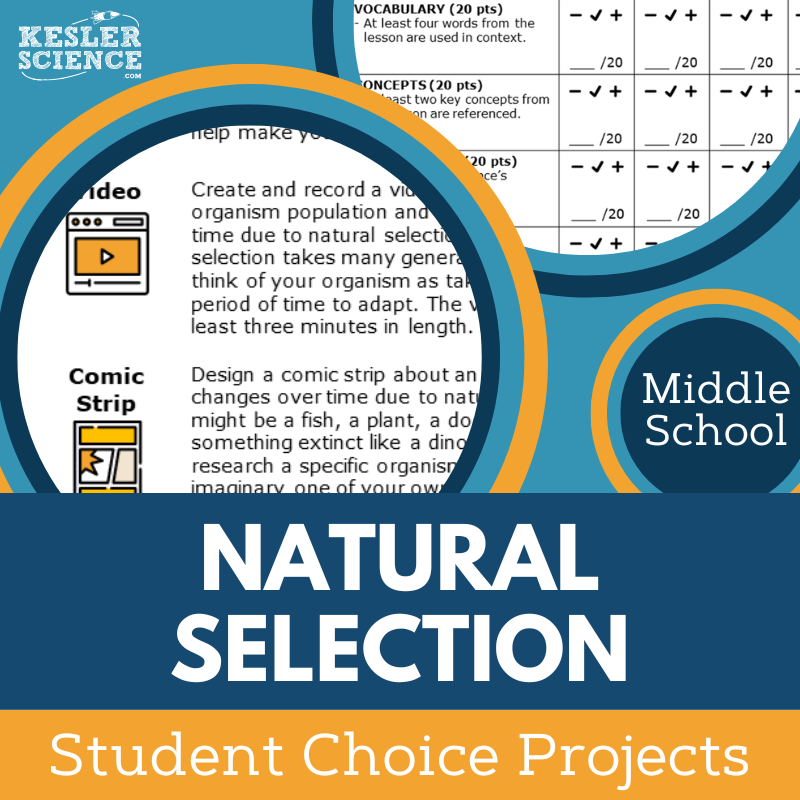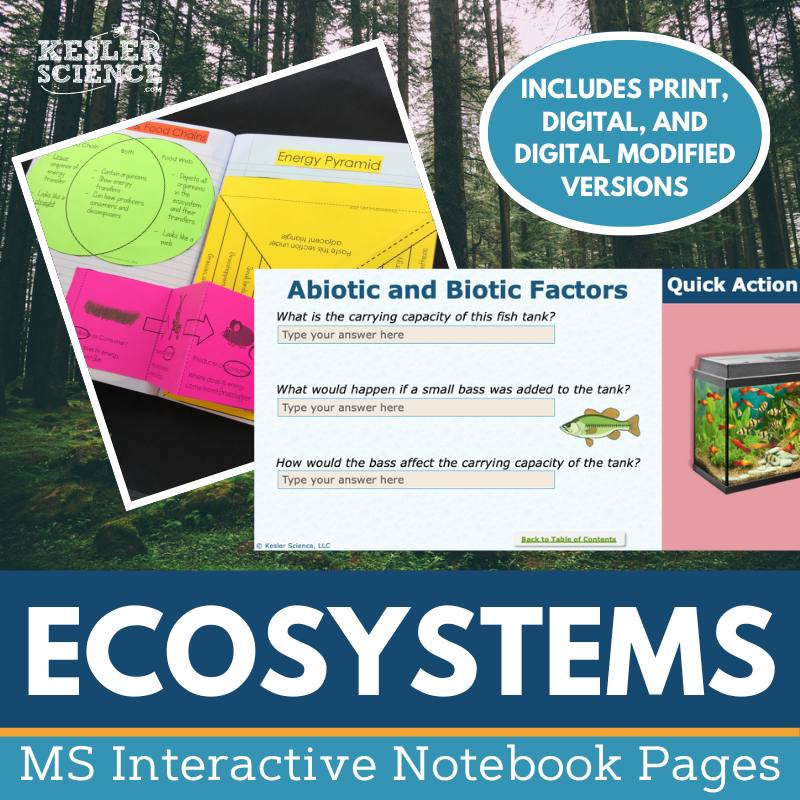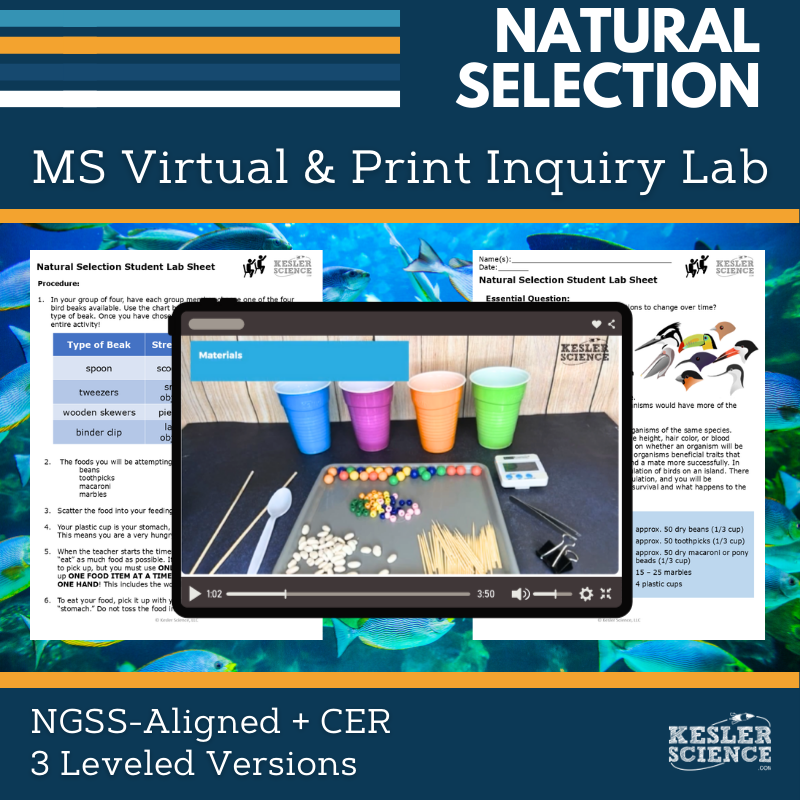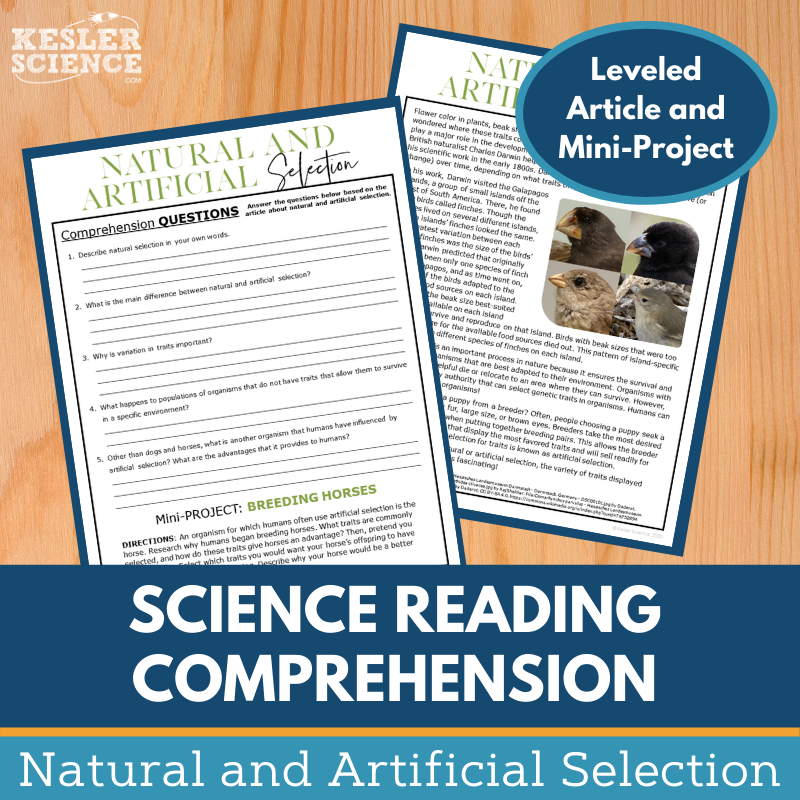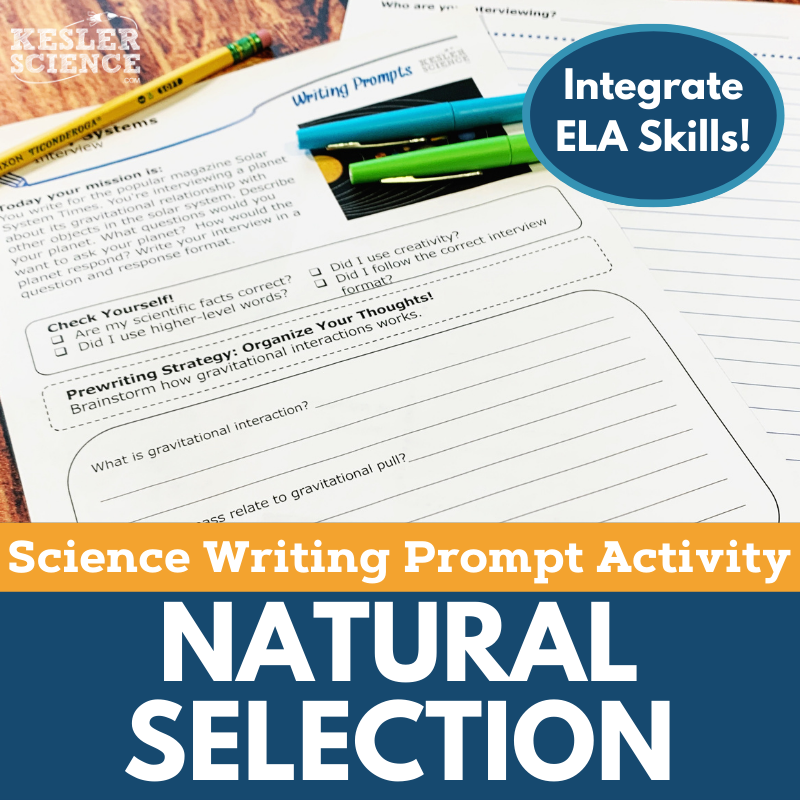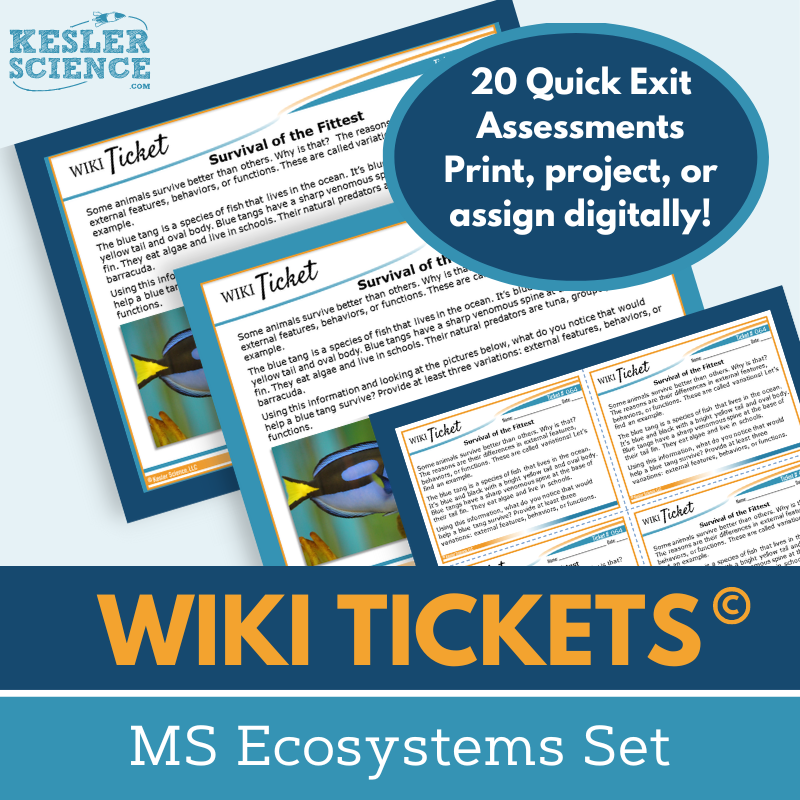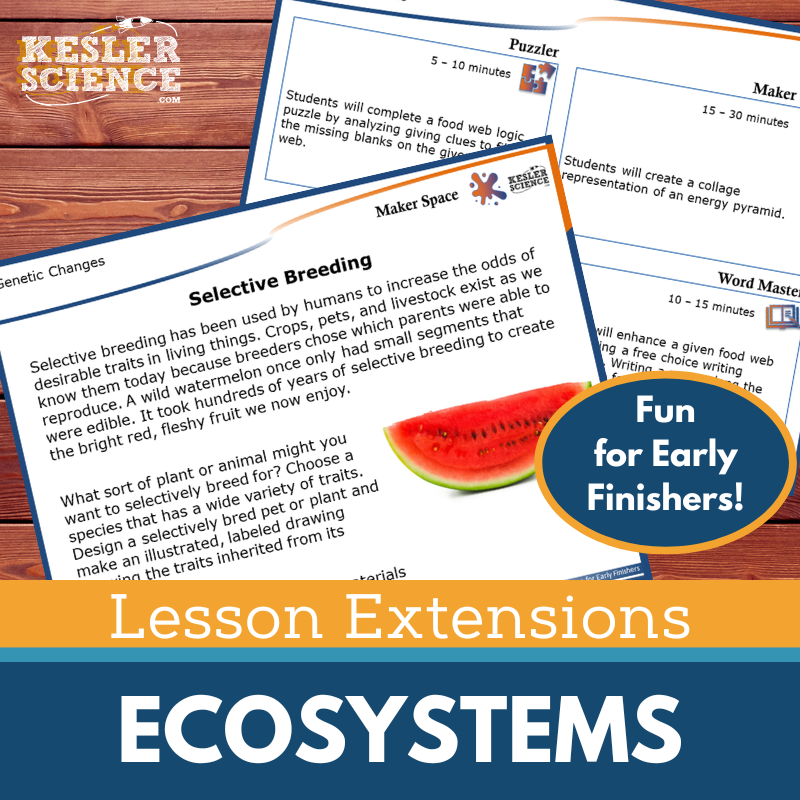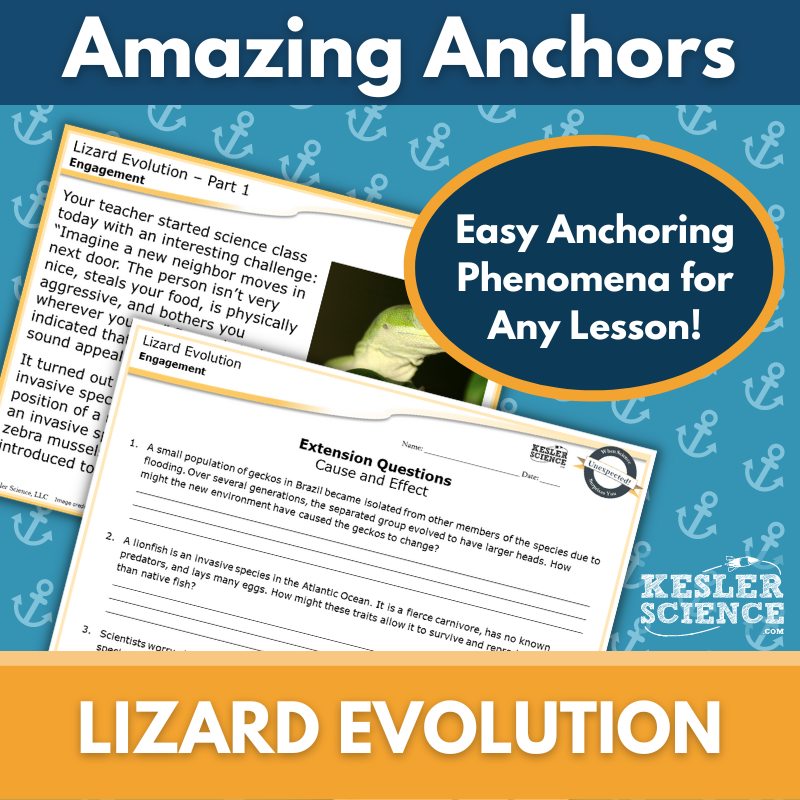Natural Selection Activities for Middle School Science
The Kesler Science Natural Selection resources provide a comprehensive, student-centered approach to understanding genetic traits and their evolution over time. The resources below will give students a comprehensive understanding of natural selection. All of the following materials are also included in the Kesler Science Membership.
The Kesler Science Natural Selection Complete 5E Lesson offers everything needed for an engaging middle school unit on changes in genetic traits over time. This fully editable, multiday lesson includes presentations, worksheets, student-choice projects, and assessments, making it easy for teachers to facilitate student-led learning with minimal prep. Students will explore key concepts, such as how to identify changes in genetic traits and the differences between natural selection and selective breeding.
Designed around the 5E model, this lesson guides students through engagement, exploration, explanation, elaboration, and evaluation. The Exploration phase features a student-led station lab with nine differentiated stations, allowing students to learn through multimodal activities like experiments, readings, videos, and research. Output stations such as "Organize It!" and "Illustrate It!" offer students the opportunity to demonstrate their understanding through hands-on activities and writing prompts.
This versatile resource is available in both printable and digital formats, with Spanish translations for vocabulary and materials. It is perfect for in-person or virtual classrooms, offering tools like editable PowerPoints, interactive notebooks, and assessments tailored to various learning needs. Whether used for reinforcement, extension, or enrichment, this comprehensive lesson ensures that all students can deeply engage with the content.
The Kesler Science Natural Selection Complete 5E Lesson offers everything needed for an engaging middle school unit on changes in genetic traits over time. This fully editable, multiday lesson includes presentations, worksheets, student-choice projects, and assessments, making it easy for teachers to facilitate student-led learning with minimal prep. Students will explore key concepts, such as how to identify changes in genetic traits and the differences between natural selection and selective breeding.
Designed around the 5E model, this lesson guides students through engagement, exploration, explanation, elaboration, and evaluation. The Exploration phase features a student-led station lab with nine differentiated stations, allowing students to learn through multimodal activities like experiments, readings, videos, and research. Output stations such as "Organize It!" and "Illustrate It!" offer students the opportunity to demonstrate their understanding through hands-on activities and writing prompts.
This versatile resource is available in both printable and digital formats, with Spanish translations for vocabulary and materials. It is perfect for in-person or virtual classrooms, offering tools like editable PowerPoints, interactive notebooks, and assessments tailored to various learning needs. Whether used for reinforcement, extension, or enrichment, this comprehensive lesson ensures that all students can deeply engage with the content.
The Kesler Science Natural Selection Station Lab provides a modular, student-led learning experience that explores the concept of natural selection. Featuring eight differentiated stations plus a bonus challenge station, this engaging activity allows students to take control of their learning while teachers guide the process. With minimal prep, this lab keeps middle school students actively involved and allows for personalized learning.
The nine stations include both input and output activities, offering a multimodal approach to learning. Input stations like "Explore It!" and "Read It!" help students learn through hands-on experiments, reading passages (available in English and Spanish), and online research. Output stations such as "Organize It!" and "Write It!" allow students to demonstrate their understanding by categorizing, drawing, and answering prompts.
This versatile station lab is ideal for both in-person and virtual settings. With comprehensive resources, task cards, and extension activities for early finishers, students can deepen their knowledge of natural selection and engage with the content at their own pace.
The Kesler Science Natural Selection Station Lab provides a modular, student-led learning experience that explores the concept of natural selection. Featuring eight differentiated stations plus a bonus challenge station, this engaging activity allows students to take control of their learning while teachers guide the process. With minimal prep, this lab keeps middle school students actively involved and allows for personalized learning.
The nine stations include both input and output activities, offering a multimodal approach to learning. Input stations like "Explore It!" and "Read It!" help students learn through hands-on experiments, reading passages (available in English and Spanish), and online research. Output stations such as "Organize It!" and "Write It!" allow students to demonstrate their understanding by categorizing, drawing, and answering prompts.
This versatile station lab is ideal for both in-person and virtual settings. With comprehensive resources, task cards, and extension activities for early finishers, students can deepen their knowledge of natural selection and engage with the content at their own pace.
The Natural Selection Student Choice Projects lesson gives middle school students the flexibility to choose from nine project options or create their own, allowing them to demonstrate their understanding of natural selection in a way that suits their learning style. The project page includes a grading rubric that can be modified for teacher, peer, or self-assessment, making it versatile and adaptable to your classroom needs.
This lesson is differentiated for various learning needs, with a modified version of the project page offering additional support for students needing remediation. For more advanced learners, teachers can assign a combination of projects, all while using the same editable rubric to assess vocabulary, concepts, presentation, and clarity.
Students can use everyday classroom materials like paper, markers, and scissors, with some projects also offering digital options. The flexible format allows for creativity while ensuring every student can showcase their understanding of natural selection through their chosen project.
The Natural Selection Student Choice Projects lesson gives middle school students the flexibility to choose from nine project options or create their own, allowing them to demonstrate their understanding of natural selection in a way that suits their learning style. The project page includes a grading rubric that can be modified for teacher, peer, or self-assessment, making it versatile and adaptable to your classroom needs.
This lesson is differentiated for various learning needs, with a modified version of the project page offering additional support for students needing remediation. For more advanced learners, teachers can assign a combination of projects, all while using the same editable rubric to assess vocabulary, concepts, presentation, and clarity.
Students can use everyday classroom materials like paper, markers, and scissors, with some projects also offering digital options. The flexible format allows for creativity while ensuring every student can showcase their understanding of natural selection through their chosen project.
The Kesler Science Ecosystems Interactive Notebook Bundle provides an engaging and interactive way for students to explore key ecosystems concepts. Designed for flexibility, the resource includes both print and digital versions, making it suitable for traditional classrooms, 1:1 environments, and distance learning settings.
The bundle covers a wide range of topics, including biotic and abiotic factors, biomes, food webs, symbiosis, and the nitrogen and carbon cycles. Digital features include a unique interactive notebook PowerPoint, editable Google Slides compatibility, reflection pages, and modified versions for students with accommodations. The paper version includes blank and pre-filled templates, complete with color examples to guide students and teachers.
This resource supports differentiated instruction and accommodates all learners with thoughtfully designed templates and modifications. Whether in person or online, the Ecosystems Interactive Notebook promotes active learning, critical thinking, and scientific literacy.
The Kesler Science Ecosystems Interactive Notebook Bundle provides an engaging and interactive way for students to explore key ecosystems concepts. Designed for flexibility, the resource includes both print and digital versions, making it suitable for traditional classrooms, 1:1 environments, and distance learning settings.
The bundle covers a wide range of topics, including biotic and abiotic factors, biomes, food webs, symbiosis, and the nitrogen and carbon cycles. Digital features include a unique interactive notebook PowerPoint, editable Google Slides compatibility, reflection pages, and modified versions for students with accommodations. The paper version includes blank and pre-filled templates, complete with color examples to guide students and teachers.
This resource supports differentiated instruction and accommodates all learners with thoughtfully designed templates and modifications. Whether in person or online, the Ecosystems Interactive Notebook promotes active learning, critical thinking, and scientific literacy.
The Natural Selection Inquiry Lab aligns with NGSS MS-LS4-4 and helps students construct explanations about how genetic variations in a population affect survival and reproduction. Students explore beak variation in birds, understanding how certain traits can provide advantages in specific environments. The lab allows students to observe how different “beak” tools interact with various “foods,” helping them grasp how natural selection drives changes in populations over time.
This resource includes three differentiated versions—dependent, modified, and independent—to meet the needs of all learners. Each version is available in both print and digital formats, with comprehension questions, Claim-Evidence-Reasoning (C.E.R.) prompts, and reflection sections. The digital lab includes a full demonstration video, guiding students through the investigation using common classroom materials like tweezers, spoons, and beans.
Teachers can choose between hands-on or virtual delivery depending on their classroom needs. Editable files are compatible with Google Slides and PowerPoint, and teacher resource pages include answer keys, objectives, prep information, and suggestions for implementation. Whether in person or online, this lab offers an engaging, multimodal approach to teaching natural selection.
The Natural Selection Inquiry Lab aligns with NGSS MS-LS4-4 and helps students construct explanations about how genetic variations in a population affect survival and reproduction. Students explore beak variation in birds, understanding how certain traits can provide advantages in specific environments. The lab allows students to observe how different “beak” tools interact with various “foods,” helping them grasp how natural selection drives changes in populations over time.
This resource includes three differentiated versions—dependent, modified, and independent—to meet the needs of all learners. Each version is available in both print and digital formats, with comprehension questions, Claim-Evidence-Reasoning (C.E.R.) prompts, and reflection sections. The digital lab includes a full demonstration video, guiding students through the investigation using common classroom materials like tweezers, spoons, and beans.
Teachers can choose between hands-on or virtual delivery depending on their classroom needs. Editable files are compatible with Google Slides and PowerPoint, and teacher resource pages include answer keys, objectives, prep information, and suggestions for implementation. Whether in person or online, this lab offers an engaging, multimodal approach to teaching natural selection.
The Kesler Science Reading Comprehension Activity on natural and artificial selection captivates middle school students with a nonfiction article exploring genetic trait changes over generations. After reading, students answer comprehension questions and delve deeper by researching artificial selection in horse breeding. This lesson enhances science literacy and critical thinking while fostering an understanding of selective breeding and natural selection.
This resource includes leveled reading passages (Lexile levels 1100–1300) suitable for grades 6–8, engaging questions, and a hands-on mini-project. The colorful materials, Cornell notes template, and versatile formats make it easy to integrate into classroom instruction, sub plans, or extra credit. Perfect for whole-class lessons, independent work, or small groups, the activity supports science literacy while enriching content understanding.
Designed for both in-person and virtual learning, the passages and activities are compatible with Google Classroom, Schoology, Canvas, and more. Students can interact directly with digital files, and teachers can use the materials to spark discussions, enhance science comprehension, and build reading routines in their classrooms.
The Kesler Science Reading Comprehension Activity on natural and artificial selection captivates middle school students with a nonfiction article exploring genetic trait changes over generations. After reading, students answer comprehension questions and delve deeper by researching artificial selection in horse breeding. This lesson enhances science literacy and critical thinking while fostering an understanding of selective breeding and natural selection.
This resource includes leveled reading passages (Lexile levels 1100–1300) suitable for grades 6–8, engaging questions, and a hands-on mini-project. The colorful materials, Cornell notes template, and versatile formats make it easy to integrate into classroom instruction, sub plans, or extra credit. Perfect for whole-class lessons, independent work, or small groups, the activity supports science literacy while enriching content understanding.
Designed for both in-person and virtual learning, the passages and activities are compatible with Google Classroom, Schoology, Canvas, and more. Students can interact directly with digital files, and teachers can use the materials to spark discussions, enhance science comprehension, and build reading routines in their classrooms.
The Natural Selection Science Writing Activity engages middle school students in a creative, interview-style writing prompt that reinforces their understanding of life science concepts. Using a question-and-answer format, students respond as if being interviewed by a science journalist, encouraging exploration and critical thinking. Designed for print or digital use, this low-prep, high-engagement activity supports both classroom and virtual learning environments.
Aligned with NGSS and TEKS standards, this resource includes teacher directions, rubrics, projection and print versions, and a digital interactive format compatible with Google Slides or PowerPoint. Full- and half-sheet handouts support a range of student needs, and the materials work well for writing journals or interactive notebooks. Students can work independently while teachers easily facilitate or assess learning.
This versatile writing prompt is ideal for cross-curricular projects, early finisher tasks, extra credit, pre-assessments, make-up work, or TELPAS samples. It’s an excellent way to differentiate instruction and provide meaningful review or enrichment for students who already have a basic understanding of natural selection.
The Natural Selection science writing activity engages middle school students in a creative, interview-style writing prompt that reinforces their understanding of life science concepts. Using a question-and-answer format, students respond as if being interviewed by a science journalist, encouraging exploration and critical thinking. Designed for print or digital use, this low-prep, high-engagement activity supports both classroom and virtual learning environments.
Aligned with NGSS and TEKS standards, this resource includes teacher directions, rubrics, projection and print versions, and a digital interactive format compatible with Google Slides or PowerPoint. Full- and half-sheet handouts support a range of student needs, and the materials work well for writing journals or interactive notebooks. Students can work independently while teachers easily facilitate or assess learning.
This versatile writing prompt is ideal for cross-curricular projects, early finisher tasks, extra credit, pre-assessments, make-up work, or TELPAS samples. It’s an excellent way to differentiate instruction and provide meaningful review or enrichment for students who already have a basic understanding of natural selection.
The Kesler Science Ecosystems WIKI Tickets are versatile formative assessments designed for 6th-8th grade science topics. These engaging assessments come in five formats for each topic: full screen for projection, three handout sizes (full, split, and quarter-page), and a digital interactive version that can be used as an editable PPT or Google Slides file. Perfect for checking understanding, these WIKI Tickets provide flexible options for in-person and virtual learning environments.
Aligned with NGSS and TEKS standards, each WIKI Tickets set includes a variety of topics like biodiversity, ecosystems, photosynthesis, and human impact. A bonus table of contents helps teachers quickly find the alignment for each standard. Some topics even have multiple tickets to reinforce key concepts and support student learning.
These assessments are ideal for use as exit tickets, bellringers, or anytime you need quick feedback on student progress. With digital and print formats available, they can be easily adapted for any classroom setting, providing a fun and effective way to gauge students' understanding of science concepts.
The Kesler Science Ecosystems WIKI Tickets are versatile formative assessments designed for 6th-8th grade science topics. These engaging assessments come in five formats for each topic: full screen for projection, three handout sizes (full, split, and quarter-page), and a digital interactive version that can be used as an editable PPT or Google Slides file. Perfect for checking understanding, these WIKI Tickets provide flexible options for in-person and virtual learning environments.
Aligned with NGSS and TEKS standards, each WIKI Tickets set includes a variety of topics like biodiversity, ecosystems, photosynthesis, and human impact. A bonus table of contents helps teachers quickly find the alignment for each standard. Some topics even have multiple tickets to reinforce key concepts and support student learning.
These assessments are ideal for use as exit tickets, bellringers, or anytime you need quick feedback on student progress. With digital and print formats available, they can be easily adapted for any classroom setting, providing a fun and effective way to gauge students' understanding of science concepts.
Lesson Extensions provide engaging, student-choice activities designed to challenge early finishers and deepen their understanding of life science concepts aligned with NGSS and TEKS standards. These resources are ideal for wrapping up lessons, filling transition times, and keeping students actively learning through rigorous yet enjoyable tasks.
Each Lesson Extension includes four components: Puzzler activities that enhance problem-solving skills, Maker Space tasks that integrate STEAM with hands-on creation, Tech Connection projects that apply digital learning, and Word Master prompts that foster science-based creative writing. These flexible activities support independent learning and help students extend their critical thinking.
Included materials feature teacher directions, answer keys, and both projection and print-ready formats in full and half-sheet versions. Topics covered span key life science standards such as cells, heredity, body systems, adaptations, natural selection, and more, offering high-quality enrichment for students ready to explore beyond the core lesson.
Lesson Extensions provide engaging, student-choice activities designed to challenge early finishers and deepen their understanding of life science concepts aligned with NGSS and TEKS standards. These resources are ideal for wrapping up lessons, filling transition times, and keeping students actively learning through rigorous yet enjoyable tasks.
Each Lesson Extension includes four components: Puzzler activities that enhance problem-solving skills, Maker Space tasks that integrate STEAM with hands-on creation, Tech Connection projects that apply digital learning, and Word Master prompts that foster science-based creative writing. These flexible activities support independent learning and help students extend their critical thinking.
Included materials feature teacher directions, answer keys, and both projection and print-ready formats in full and half-sheet versions. Topics covered span key life science standards such as cells, heredity, body systems, adaptations, natural selection, and more, offering high-quality enrichment for students ready to explore beyond the core lesson.
This Amazing Anchors Phenomenon Lesson introduces and reinforces the concept of natural selection through real-world connections. Students begin with a reading about genetic trait changes in Florida lizard species, accompanied by comprehension and extension questions to spark curiosity and prepare for deeper learning. A second reading explains the science behind how certain traits are naturally selected, helping students better understand the mechanisms driving evolution.
Aligned with NGSS standard LS4-6, this no-prep resource includes teacher directions with answer keys, editable materials, and options for both print and digital formats. It features projection slides, full- and half-sheet handouts, and editable PowerPoints that integrate easily into Google Classroom or other LMS platforms. A differentiated version offers sentence starters and modified questions to support students who need additional guidance.
Designed to bookend a main lesson, these readings are ideal for the Engagement and Elaborate phases of the 5E model. Whether used to introduce or reinforce instruction, this lesson helps students explore genetic trait selection through an engaging, real-world phenomenon.
This Amazing Anchors Phenomenon Lesson introduces and reinforces the concept of natural selection through real-world connections. Students begin with a reading about genetic trait changes in Florida lizard species, accompanied by comprehension and extension questions to spark curiosity and prepare for deeper learning. A second reading explains the science behind how certain traits are naturally selected, helping students better understand the mechanisms driving evolution.
Aligned with NGSS standard LS4-6, this no-prep resource includes teacher directions with answer keys, editable materials, and options for both print and digital formats. It features projection slides, full- and half-sheet handouts, and editable PowerPoints that integrate easily into Google Classroom or other LMS platforms. A differentiated version offers sentence starters and modified questions to support students who need additional guidance.
Designed to bookend a main lesson, these readings are ideal for the Engagement and Elaborate phases of the 5E model. Whether used to introduce or reinforce instruction, this lesson helps students explore genetic trait selection through an engaging, real-world phenomenon.
Year-Round Resources
These year-round activities will increase your students' understanding of many middle school science topics. All of these activities are also included in the Kesler Science Membership.
Visual Data & Graphing
You're not alone if your students struggle with understanding graphs, charts, and tables. It's a skill that takes an enormous amount of practice. This resource will help students build a strong foundation in analyzing data and creating their own data visualizations.
Bell Ringers and Warm-Ups
These middle school science bell ringers are an excellent way to engage your students as soon as they walk into your classroom. This comprehensive FULL YEAR resource includes everything you need to start off each science class with an interesting warm-up activity.
Review Board Games
Each game board has been carefully designed to keep students engaged. There are 10 different action spaces on each board and dozens of question cards. All of the actions are related to science concepts and keep the students motivated throughout the game.
Each game is ready to play. Simply print out the board and the cards and let the students enjoy reviewing nine different units.
Essential Questions
Below are the essential questions associated with the lessons and activities included in this unit. This topic is only one of more than 100 middle school science topics included in the Kesler Science Membership.
-
How can you identify changes in genetic traits over several generations?
-
What are the differences between natural selection and selective breeding?
Kesler Science Membership
Imagine never having to search for another middle school science lesson again. The membership gives you access to ALL of the Kesler Science products in one place (Yes, including everything above).
Say goodbye to long hours of lesson prep.

